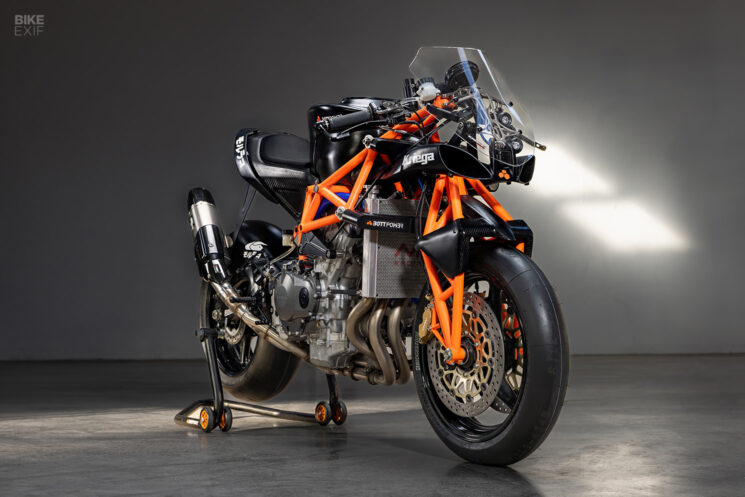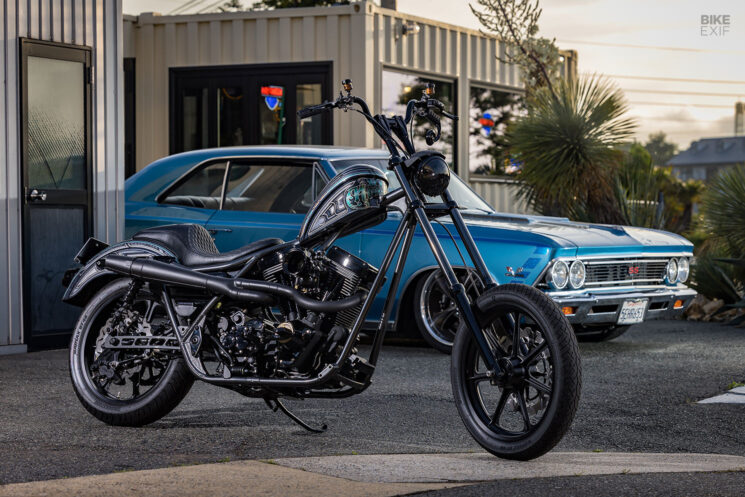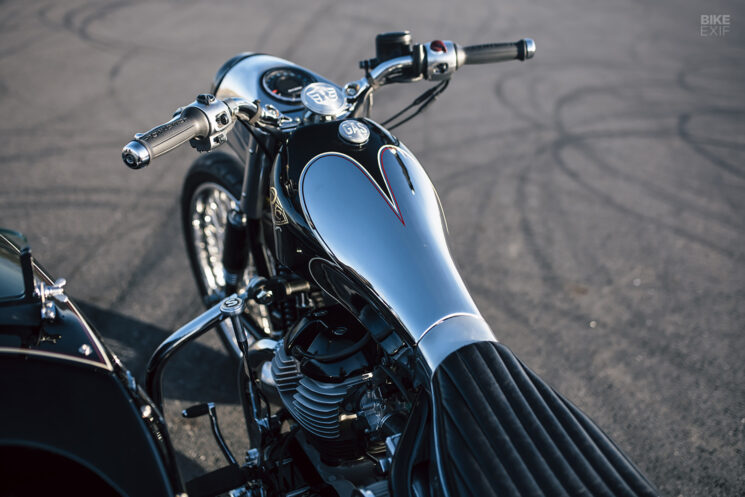
Crunching the numbers to pick the 10 best custom motorcycles of the year is a headache. But picking my personal favorites is even harder—especially when you consider the caliber of the machines that we regularly feature.
As has become my process, I start with a short list of 30 to 40 bikes, then spend a few days whittling that down to a manageable size. To level the playing field, any bikes that are already highlighted in our ranked Top 10 are eliminated, and the remaining candidates are shuffled into a final selection.
Each one of these custom motorcycles stood out for its craftsmanship, creativity, and overall ability to make jaws drop. They’re listed in alphabetical order by the builder or workshop’s name. Dive in, and feel free to yell at me in the comments if you think that I missed the mark.

Honda Fireblade ‘Morlaco’ by Bottpower Given David Sanchez’s extensive background as a top-tier motorcycle racing engineer, it’s little wonder that the motorcycles from his workshop, Bottpower, look so brashly purposeful. But this Honda CBR954RR Fireblade-powered sportbike is extreme even by Bottpower’s standards.
David dreamed up the ferocious Fireblade 21 years ago, envisioning a bike with a trellis frame, a unique front suspension system, and an exposed airbox and fuel tank. Using just the engine, wheels, and swingarm from a brand new ‘Blade, he and Bottpower co-founder, Hugo van Waaijen, got as far as building the rolling chassis before the project stalled for reasons unknown. Years later, they finally dragged it back onto Bottpower’s workbench and pushed it over the finish line.

There’s a lot to digest here. The Fireblade motor is suspended from a custom trellis frame, designed to create a chassis that is narrower and lighter than your average liter sportbike. The front suspension is very loosely based on the familiar Hossack design, but with a few key changes to make it more capable and tunable.

The Fireblade’s scant bodywork was 3D printed and reinforced with carbon fiber. Fuel is stored in a custom-made bladder (the same type of system that’s used in race cars), while the carbon fiber tail section acts as its own subframe. Under the hood, you’ll find a bespoke electrical system, complete with data acquisition capabilities.
The bike also boasts a titanium exhaust system with an Akrapovič muffler and custom-made shocks from TFX Suspension in The Netherlands. David calls it ‘Morlaco,’ which loosely translates as ‘large fighting bull.’ [More]

Yamaha RZV500R by Championship Cycles Mike Vienne runs Championship Cycles in Los Angeles, California, with a philosophy we can all get behind; “Less is more—because more is heavy, and heavy is slow.” So when a 1985-model Yamaha RZV500R rolled into his workshop, he saw much room for improvement—despite the bike’s rarity and icon status.
The Japanese market-only RZV500R was specced with an aluminum frame, a longitudinally-mounted rear shock, and the quirky combination of a 16” front and 18” rear wheel. But it was also neutered by Japanese emissions regulations at the time—so although it was based on the 88 hp RZ500, it only made 64 hp. Mike’s mission was to right those wrongs.

He kept the RZV’s hand-welded aluminum frame but replaced the front and rear subframes, swingarm, rear-set pegs, and suspension linkages for CNC-machined items, courtesy of well-known fabricator Mark Atkinson. The new forks and shock are from Nitron, and the new wheels are lightweight forged aluminum Dymag items.
Mike resisted the urge to massage the RZV into a Wayne Rainey Marlboro replica, opting instead for an homage to the GP bikes that raced in the Daytona 200 in the early 1980s. Modified classic Yamaha fairings do duty up front, followed by custom-made carbon fiber parts for the tank and rear cowl. The two-stroke engine has been rebuilt to the tune of 100 hp, the quadruple pipes are new, and the livery is retro-fabulous. [More]

Suzuki Katana by dB Customs We’re suckers for the 80s sportbike restomods that Darren Begg builds. So adding this brooding Suzuki GSX1100S Katana to this list was an easy decision.
Like all of Darren’s builds, the 82-model Katana has a stylish form-following-function vibe going on. The all-black paint job is all-business—and the bike has a spec sheet to back it up. The engine now runs 1,216 cc Wiseco pistons, with oversized valves, upgraded camshafts and rods, and extensive head work.

It inhales through a set of Yoshimura carbs, and out through a Racefit titanium exhaust system. Öhlins suspension components do duty at both ends, Dymag hoops shave weight and add style, and Brembo brakes slow the whole thing down.
The bike’s silhouette is flawless. It wears a new-old-stock Katana fairing with carbon fiber fins from Magical Racing, a tail cowl from Unicorn Japan, and a seat from Daytona and AC Sanctuary. From the extremely well-specced cockpit to the numerous high-end fittings, there’s nothing on this Katana that hasn’t been improved. [More]

Harley-Davidson Sportster by Hazard Motorcycles I might catch flak for including a wood-trimmed motorcycle on this list, but this Harley-Davidson Sportster is handily one of the most elegant bikes to grace these pages this year. Built by Matteo Fustinoni at Hazard Motorcycles, it’s a tribute to one of the most exquisite boats ever made: the Lamborghini Riva Aquarama.
Matteo grew up on Lago d’Iseo—the home of Riva boat works—so the legendary wooden watercraft hold a special place in his heart. Ferruccio Lamborghini’s personal Riva Aquarama is particularly mythical. The story goes that he ordered the Aquarama, then sent Riva two V12 Lamborghini engines to power it, instead of the American-made V8s that the Aquarama normally used.

Matteo’s Sportster pays homage to the Lambo-powered Riva’s notable speed with its drag-bike silhouette. The elegant front fairing hides a springer fork, which grips an 18” Laverda wheel. Out back, the rigid tail is anchored to a 16” wheel with a Racemaster slick.
The wooden inlays that adorn the fairing and custom split fuel and oil tanks, and the blue and white highlights, are direct nods to the color scheme of Sig. Lamborghini’s boat. Several custom-made badges and trim parts add to the mystique. But there are subtler details too—like the way the Sportster’s front cylinder has been rotated to accommodate two Weber carbs, as seen on the Aquarama. [More]

Zero ‘SR-X’ by Huge Moto Good design never goes out of style. Seven years ago, Huge Moto founder Bill Webb released renders of a Honda CBR1000RR-based concept bike called the ‘MONO RACR.’ This year, Bill adapted it to suit Zero Motorcycle’s electric sportbike, the SR/S—and the design still feels as fresh as it did when he first penned it.
Huge Moto’s ‘Zero SR-X’ maintains the donor bike’s 110-horsepower motor, Showa suspension, and J.Juan brakes. But it’s been re-dressed to exhibit the sort of aggressive sci-fi aesthetic that Huge Moto is known for. A futuristic fairing and wide LED headlight sits up front, the top of the bodywork is deeply sculpted to accommodate the OEM dash and ignition, and the whole design tapers to the waspish tail section.

The bodywork not only looks incredible, but also strategically hides some of the bike’s drivetrain while emphasizing the better-looking mechanical bits. According to Bill; “The biggest challenge with electric drivetrains is the lack of visual interest.” The Zero SR-X’s modular bodywork solves this.
Despite the strikingly simple livery, there’s plenty to look at here—and there’s plenty of inspiration for Zero’s next factory bike. [More]
![]()
Yamaha MT07 flat tracker by Jeff Palhegyi A good chef can take a refrigerator full of leftovers, and turn it into a magical dish. And Jeff Palhegyi’s fridge is full of leftovers—if you’ll pardon the metaphor.
Jeff’s experience as a fabricator and frame builder means he’s well-versed in the art of building flat track race bikes. This particular build uses the same template as the MT07-DT—a Yamaha MT07-derived race bike that Estenson Racing has been running in the US flat track TT racing series. Jeff was instrumental in developing the MT07-DT, so he knows the bike inside-out.
![]()
With countless Yamaha MT07-DT flat track frames already built by his workshop, Palhegyi Design, Jeff decided to gather up leftover parts from four different prototypes to put his very own MT07-DT together. A chromoly trellis frame was welded together and then fitted with a 2021 Yamaha MT-07 motor. A tubular swingarm sits out back, mounted on an eccentric pivot that offers a full range of adjustability.
Carbon fiber bodywork is perched on top, finished with replica Estenson Racing graphics and a Saddlemen seat. The bike also sports Öhlins suspension, Brembo brakes, Roland Sands Design wheels, and a handful of lust-worthy Yamaha Racing items. With an abundance of premium parts, Jeff’s flat tracker is ready to tear up the nearest TT track—even if racing it was never his intention. [More]
![]()
Harley-Davidson Pan America by Motocrew Although many were skeptical about the idea of Harley-Davidson releasing an adventure bike, the H-D Pan America was well-received when it hit the market. But what no-one saw coming, was how good it looks when you denude it of its chunky bodywork.
This gnarly Pan Am is the work of Chris Scholtka—the German firefighter-slash-custom bike builder behind the Motocrew name. He built it as a collaboration with the aftermarket accessories giant Touratech, to showcase the company’s suspension offerings. Chris settled on the idea of turning the Pan-Am into a flat tracker and got to work.
![]()
Chris first fabricated a new subframe to accommodate a slimmer seat, then realized that the OEM fuel tank was too big by comparison. So he fabricated a new aluminum fuel cell, and then cut and shut the original plastic tank cover to shrink it down, but still retain some of the Pan-Am’s factory look. Poking out the front of the tank cover is an oversized K&N air filter, mounted on a 3D-printed intake.
![]()
Flat track-specific mods include 19” wheels and a dummy caliper to replace the front brake. A Husqvarna FC450 fender finishes off the tail, with the Harley’s original LED taillight mounted underneath it. Plexiglass side covers highlight the custom Touratech suspension, with a cutout for the preload dial.
Finished in a frantic livery, Motocrew’s Harley Pan America not only looks bonkers but also makes 9.9 hp and 12 Nm more than before—and weighs 32 kilos [70.5 lbs] less. [More]

NU-E concept by NUEN MOTO Should electric motorcycles conform to traditional motorcycle design norms or tread new ground? This sleek prototype from Vietnam’s NUEN MOTO dodges the debate completely by doing a bit of both.
NUEN created the ‘NU-E’ as a prototype—a proof of concept for a production bike that they hope to eventually bring to market. Their team is made up of designers and bike builders from Vietnam, Sweden, and the USA, and the mix of influences is clear. Starting with sketches, NUEN created a CAD rendering, which was then used to 3D-print a mock-up of the chassis.

It’s hard to tell where the CNC-machined aluminum chassis ends, and where the bodywork begins. Bespoke side panels hide the battery and controller, while 80s turbofan-style rear wheel covers hide the bike’s hub motor. NUEN used a hub motor for this prototype because it served the minimalist vibe that they were after, but the next iteration will likely run with a mid-mounted unit.
K-Tech forks and a Triumph Trident wheel sit up front, with a repurposed Yamaha R1 swingarm and an EMC shock out back, connected via custom linkages. NUEN also specced the NU-E with Swedish-made ISR brakes, clip-on handlebars, and Hookie Co. grips. There’s also a Quad Lock smartphone mount so that you can use your phone as a speedo.

The NU-E’s finishes are delightfully Scandinavian, with stark aluminum and black surfaces punctuated by sharp blue highlights. The full-length upholstery that runs across the top of the bike is the perfect finishing touch for this neo-futuristic electric prototype. [More]

Yamaha R9 concept by Seb Hipperson We’ve been waiting forever for Yamaha to pop the MT-09’s sublime triple-cylinder engine into a sportbike to create an ‘R9.’ But all they’ve given us so far is a fully-faired version of the XSR 900; the Yamaha XSR 900 GP.
While the XSR 900 GP is delightful in its own way, it’s unlikely to satisfy sportbike fanatics who want something more purpose-built. London-based fabricator and furniture maker Seb Hipperson has the answer. He got so tired of waiting for Yamaha, that he built his own R9 prototype from the ground up.

Seb used the cradle from a Yamaha TRX850 as the foundation for the chassis, which he fleshed out with a TIG-welded steel trellis frame. A set of Ducati Panigale forks with Bitubo internals run up front, with a Ducati 749 swingarm out back, matched to a Corse Dynamics linkage and a Mupo Race Suspension shock. The wheels are five-spoke alloy hoops from an Aprilia RSV Mille, and the brake calipers are Brembos.

Visually, Seb’s influences came from the two-stroke GP race bikes of the 90s. The fairing, belly pan, and tail section were all shaped from fiberglass. The tank is a two-piece affair; a fiberglass airbox at the front and an aluminum fuel reservoir at the back.
Finished in an extremely well-judged red, white, and black ‘speedblock’ livery, Seb’s Yamaha has haunted our dreams since it hit our inbox. The ‘official’ Yamaha R9 will have some big shoes to fill when it finally breaks cover. [More]

Harley-Davidson Dyna by Sureshot It’s easy to add stacks of details to a custom motorcycle, but it’s hard to do so without making it look cluttered and overblown. This Dyna managed to claim the ‘Best Detail Work’ title at the esteemed Mooneyes Show at the end of last year—yet there’s no one part on it that screams for attention.
It’s the work of Takuya Aikawa at Sureshot in Chiba, near Tokyo. His forte is building skinny cruisers with a performance vibe, and his accolades include two HRCS ‘Best in Show’ awards. As with most of his bikes, the fabrication work on this 1998-model Harley-Davidson FXD Dyna Super Glide could fill volumes.

Aikawa-san modified the Dyna’s frame with a new oval backbone, and redesigned the subframe to taper towards the custom aluminum mono-shock swingarm. The front suspension system was built from scratch, and both ends were fitted with Racing Bros shocks. The one-off wheels measure 19” at the front and 18” at the back; the brake discs and rear sprocket all sit on the left side, leaving the wheels ’empty’ on the right side.
Takuya rebuilt the late-90s V-twin with fresh billet aluminum heads from Speed and Science, and fabricated a custom manifold to accommodate a Keihin FCR41 downdraft twin carb with velocity stacks. A handmade cover ties the stacks to the handmade fuel tank, which traces a line down to the slim tracker-inspired seat.

Mounted to the left of the engine is a custom hand-shifter that uses a series of connecting rods and CNC-machined linkages. Everything has been considered—from the dimpled leather shifter knob cover to the layered spoke patterns that are etched into the wheels. Finished in a sparkling paint job that gets better as you get closer, Sureshot’s Dyna is worthy of both its Mooneyes trophy and its inclusion on this list. [More]

EDITOR’S NOTE It would be remiss of me not to tip my hat to the bikes that narrowly missed this year’s selection. Those would be Krautmotors’ pink Kawasaki H1 [above], Colt Wrangler’s prizewinning H-D Sportster, and Kaffeemaschine’s minimalist Moto Guzzi café racer series.
One bike in particular deserves an honorable mention; Balamutti’s Ducati Pantah-powered BMX [below]. Equal parts kooky and ingenious, this bright green oddity landed just outside both our ranked list and my personal Top 10. (And it even features a built-in Scotch reservoir.)

Bikes that made my short list, but had already ranked in our primary Top 10, include 10 ’til 12’s wild BMW boxer enduro, Kalapea Garage’s slick Ducati café racer, Mule’s Harley Sportster flat tracker, and the bike that took this year’s top spot, the PiperMoto J Series scooter. Rough Crafts’ Honda CB1100 [below] was in the mix, too.
My personal thanks to everyone that makes Bike EXIF tick; custom builders, photographers, writers, advertisers, and you, our faithful readers. Happy New Year, and see you again in a few days.

from Bike EXIF https://ift.tt/af7MCi3



















